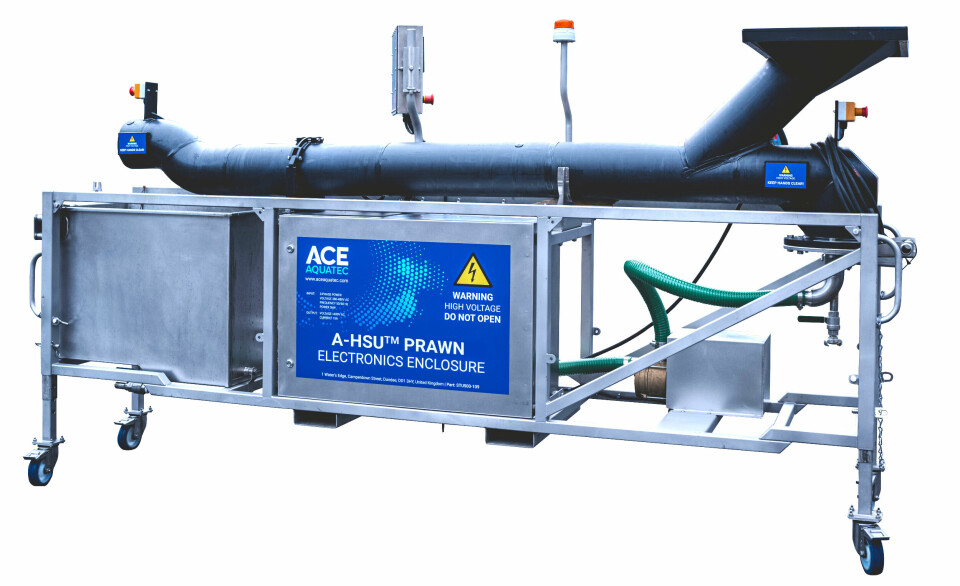
Ace Aquatec launches prawn stunner
New version of device is a ‘remarkable progression in welfare’ for decapods
Dundee-based aquaculture innovator Ace Aquatec is launching a new version of its in-water electric stunner, for the prawn industry.
Ace Aquatec’s Humane Stunner Universal (HSU), which renders fish unconscious without removing them from water, is already used by finfish farmers producing salmon, trout, and other species. Customers include Scotland’s second largest salmon producer, Scottish Sea Farms.
The launch of the portable prawn stunner, called the Prawn A-HSU, was taking place today at Seafood Expo North America (SENA) in Boston.
The launch follows on from successful trials on Pacific white shrimp (Litopenaeus vannamei) in Germany with recirculating aquaculture system (RAS) company Neomar and its subsidiary, Förde Garnelen, a land-based R&D shrimp farm; and with German RAS-tech and shrimp farming company Crusta Nova.
Sentience awareness
A market is developing for humane slaughter of shrimp due to increasing legal recognition of welfare needs.
The scope of the Animal Welfare (Sentience) Bill in the UK has been extended to recognise lobsters, octopus and crabs and all other decapod crustaceans (e.g. prawns) and cephalopod molluscs as sentient beings, explained Ace Aquatec.
The European Food Safety Authority (EFSA) also considers decapod crustaceans to have the capability to experience pain, suffering, and distress. This means greater focus has been placed on the development of humane methods of slaughter for these animals.
The new Prawn A-HSU, developed in collaboration with scientists from the Silsoe Research Institute, stuns the prawns unconscious in less than one second, minimising their sensitivity to pain at slaughter without compromising quality or shelf-life.
Long insensibility
The process begins with prawns being pumped or brailed into the entrance chute, where they flow directly into the water of the stun tube. The electric field in the stun tube ensures that they lose consciousness immediately and are maintained in the fields in order to maintain long insensiblity after removal from the water.
The whole process takes 40 seconds from start to finish and means prawns are not removed from the water, which research has shown causes them to react badly and become stressed.
Ace Aquatec chief executive Nathan Pyne-Carter said: “We know that current slaughter practices, including boiling alive, chilling, dismembering, CO₂, high pressure processing, asphyxiation or immersion in ice slurry, are all harmful for shrimp welfare.
“Thanks to the inclusion of decapod crustaceans in the Animal Welfare (Sentience) Act 2022, we’re now seeing retailers and producers approaching us to facilitate a humane electrical stunning process for these animals. The launch of our A-HSU for crustaceans will allow us to expand on our mission to elevate harvesting standards for all marine life, including invertebrate species.”
The trials ... saw improved outcomes for prawns, both in terms of the time taken to complete the stunning procedure and reduced exposure to pain
Bert Wecker, CEO, Neomar and Förde Garnelen
A new era
Dr Bert Wecker, chief executive of Neomar and Förde Garnelen, said: “The recent trials of the A-HSU stunner in Germany saw improved outcomes for prawns, both in terms of the time taken to complete the stunning procedure and reduced exposure to pain in the process. The implementation of this technology with an intermediate ice slurry exposition afterwards is a remarkable progression in fish welfare and quality.”
Dr Fabian Riedel, chief executive and founder of Crusta Nova, added: “Effective, safe, and rapid, in-water electric stunning is an essential component of responsible aquaculture. Crustaceans react strongly to being taken out of water which results in stress and can impact the quality of the product.
“This portable system not only challenges the status quo of outdated slaughter methods for invertebrates, but also heralds a new era of improved standards, both in terms of harvesting and in better-quality end products.”






















































